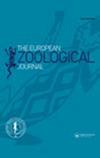Behavioural processes, ephemeral resources and spring population dynamics of an insular lizard, Podarcis lilfordi (Squamata: Lacertidae)
引用次数: 4
Abstract
Abstract Temporal changes in adult sex ratio of animal populations might be due to differences in movements, survival or detection probabilities. We used data from an intensive capture–mark–recapture study of 720 lizards at the islet of Aire (Balearic Islands, Spain) to investigate the demographic mechanisms underlying the spring uneven sex ratio. We simultaneously estimated survival (f), the proportion of transient animals (p) and the probability of recapture (p) of lizards at the study plot. We then estimated population size using open population models for individually based data and compared these with the observed values. Results indicated that males had a higher probability of recapture than females, but this was not sufficient to generate the observed male-biased sex ratio. The proportion of transient males decreased at the end of spring in parallel with the end of the blooming period of the dead horse arum, Helicodiceros muscivorus, a short-lasting food and thermoregulation resource for lizards during spring. Changes in the proportion of transients suggested that sex-dependent movements, most likely linked to a monopolising behaviour of this plant resource, were responsible for the observed difference in the number of males and females. Our results reveal how the interplay of behavioural and ecological factors explains short-term changes in population dynamics and shapes the movement patterns within the island.岛蜥的行为过程、短暂资源和春季种群动态(鳞目:蜥科)
动物种群成年性别比的时间变化可能是由于运动、生存或发现概率的差异。我们利用对西班牙巴利阿里群岛Aire岛720只蜥蜴的密集捕获-标记-再捕获研究数据,调查春季性别比例不平衡的人口统计学机制。我们同时估算了研究区域蜥蜴的存活率(f)、瞬时动物比例(p)和再捕获概率(p)。然后,我们使用基于个体数据的开放种群模型估计种群规模,并将其与观测值进行比较。结果表明,雄性比雌性有更高的再次捕获概率,但这并不足以产生观察到的雄性偏向性比例。瞬时雄虫的比例在春季结束时下降,与死马魔豆(Helicodiceros muscivorus)的花期结束同步。死马魔豆是蜥蜴在春季的短期食物和体温调节资源。瞬变比例的变化表明,性别依赖的运动,很可能与这种植物资源的垄断行为有关,是观察到的雄性和雌性数量差异的原因。我们的研究结果揭示了行为和生态因素的相互作用如何解释了人口动态的短期变化,并塑造了岛上的运动模式。
本文章由计算机程序翻译,如有差异,请以英文原文为准。
求助全文
约1分钟内获得全文
求助全文

 求助内容:
求助内容: 应助结果提醒方式:
应助结果提醒方式:


